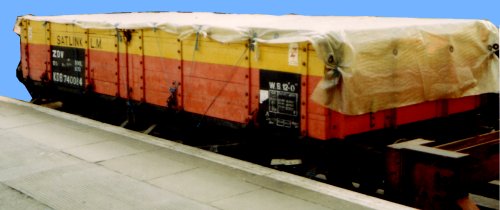British Railways Departmental Stock Liveries
NB The colours used were obtained by sampling colour pictures, they
may however vary from the true colour, use as a rough guide only
The original standard for BR departmental stock was black, this changed
in the mid 1960's to red body work with black underframes and white lettering
but this livery was not widely applied. This changed again in about 1967 to
olive green, sometimes referred to as 'olive drab'. In both cases of course
these changes took time. The BR 'fish' names continue to be painted on the
sides of many vehicles throughout this period.
The vehicles were allocated to specific departments and there was
usually a letter or letters placed on the side to indicate this, a large letter
E means the wagon is allocated to the Civil Engineers department, EM is the
rolling stock people, ST is signal and telegraph department and OD is the
operating department. After these letters was another indicating their region,
E, M, W S and Sc (for Scottish).
Departmental stock often featured both complicated lettering and
coloured shapes (indicating specific allocations) but after the introduction of
TOPS the regional allocations were abandoned as all departmental stock was
pooled. The old regional markings and additional markings gradually got painted
out.
The D prefix to the number was also changed, the plain D meant the
vehicle was the service of the Chief Civil Engineer, dealing with track,
bridges, buildings and the like. AD meant the vehicle was allocated to the
Chief Mechanical and Electrical Engineer, who deals with rolling stock, KD is
for signal and telegraph department stock, LD is stock used in electrification
projects, and TD is operations department stock.
As noted above just because a vehicle is marked as belonging to a
particular depot or even a particular train, for example a breakdown train,
does not mean that's where it will be found, these things tend to wander about
rather a lot.
In the early 1980's the departmental colour scheme changed again to
light grey and yellow, this was an adaptation of the Railfreight livery with
the lower sides of the vehicle being grey with a yellow band above. The first
vehicles to use this revised scheme were bogie ballast hoppers, painted in
1981, but the livery was applied to other vehicles as they came in for
re-painting or repair in the 1980's. Some vehicles had additional markings
applied on the yellow band.
The S&T department later adopted a variation on the engineers grey/yellow livery with a
basic red body with yellow top strip. One example was an old twelve foot wheelbase pipe
wagon, available as a kit from Parkside Dundas, parked in Manchester Piccadilly
station in the early 1990's.
Fig ___ SATLINK wagon

This had the top three planks painted yellow with
the word SATLINK in black about twelve inches (30 cm) high on the left, SAT in
this case refers to the 'signal and telegraph' department.
In practice the livery often wore off rather quickly on wagons in more arduous service, the examples below were photographed in the mid 1990s passing through Stockport station.
Fig ___ Air braked PLAICE ballast wagons

Large self-powered machines such as cranes and specialised mechanical
track maintenance vehicles are painted yellow with black markings, although I
have not been able to confirm the exact date this was introduced it was
certainly the norm by the 1970's. The track cleaning machines, trench digging
machines and what have you were introduced in the early 1960's, following a
small number built in Britain British Railways settled on machines built by the
Austrian firm Plasser.
See also 'Track - Buffer stops and Track Maintenance Personnel & Equipment' for photographs of these large machines
^
Go to top of page
International Good Guys ~ Making the world a
better place since 1971 ~ Site maintained by

All material Copyright © Mike
Smith 2003 unless otherwise credited

